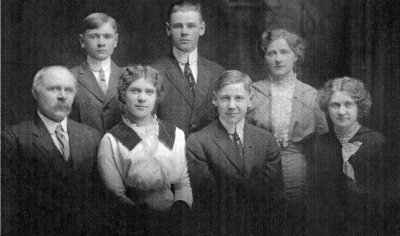
The Peters FamilyThe above photograph of my grandmother's family was probably taken around 1910 when my grandmother was in her mid-twenties. My grandmother (Amanda) is on the far right in the back row and her father (Ludwig Peters) is on the far left. Her mother Ida had died from appedicitis in 1900 at the age of 39.
Ludwig (also known as Lewis) Peters is the only one of my great-grandparents who was not an immigrant. It was instead his grandfather Christian Peters (born April 9, 1804) who came from Germany (Basepohl, Mecklenburg), although I have been unable to discover the year. Christian's oldest child was Christopher (born November 27, 1830). His oldest child was my great-grandfather Ludwig (born June 24, 1860), pictured above. His oldest child is my grandmother Amanda (born July 11, 1885).
Ludwig's father Christopher provided my lineage with its only Civil War veteran. Being thirty-four years old at the time, he was not drafted into service until December of 1864, only five months before the end of the war. But once in the army as a part of the 7th Wisconsin Infantry, Company C, he became a part of the illustrious Iron Brigade. The Iron Brigade was known as one of the most fierce fighting units in the war and was also the brigade which sustained the highest percentage of casualties during the course of the war. It had played a key role in the battle of Gettysburg, slowing the Confederate army during the first day's fighting. During the time my great-great-grandfather Christopher was a private in its ranks, the brigade (now referred to as “Kellog's Brigade” after a new commander) was pursuing the Confederate army when General Lee surrendered at Appamattox Court House, Virginia. Here is an account of that day taken from The Iron Brigade: A Military History by Alan T. Nolan— From Five Forks, Kellog's Brigade with the Fifth Corps followed in pursuit of the fleeing enemy to Jeterville, then along the Appomattox River, past Farmville and, at length, on the night of April 8th, it went into bivouac a few miles from Appomattox Court House. On the following morning the brigade resumed its advance, noticing as the day wore on that the sounds of firing ahead had ceased. Not yet at Appomattox Court House, the column halted in the late morning, and the soldiers waited. As recorded by one of the original Sauk County [Wisconsin] Rifleman: “In the afternoon, we saw an oficer come riding down the lines, his horse wet and covered with lather; as he passed along we saw that the boys’ caps went up into the air—the welkin rang with cheers....As he came in front of us he shouted ‘Gen. Lee and army have surrendered to Gen. Grant.’...We yelled for joy, for we knew the war was ended.” And, of course, it was true, “near Appomattox Court-House...the enemy, tired, dispirited, harassed, and surrounded, surrendered at discretion,” according to Kellogg's final report. Although other Confederate forces were to hold out for a few more days or weeks, for the survivors of the regiments of the Iron Brigade the end had finally come. Christopher Peters returned to his farm and his young children in Kewaunee, Wisconsin. His oldest son grew up, got married, and also became a farmer in the same area. His oldest child, my grandmother, was born in 1885. My father recently wrote of her marriage to my grandfather Herman,They were married in 1913, and setled on two quarters of land located two miles east of Crystal, ND. Dad moved a house to the northwest corner of the farm and planted a grove. Mother had been raised on a farm near Kewaunee, WI, therefore this treeless, flat land in comparison to the apple trees, streams, and hills of Wisconsin seemed pretty barren. She often spoke with longing in her voice of her life in Wisconsin. But she made the best of it and raised her six children to love the land...
It is interesting to me to hear that area—the Red River Valley in the northeastern part of North Dakota—spoken of as barren and treeless, for when I came to know that land in the 1960's as a young boy, it was green, lush, and filled with trees—the trees the early settlers and farmers like my grandparents and great-grandparents had planted.
|

